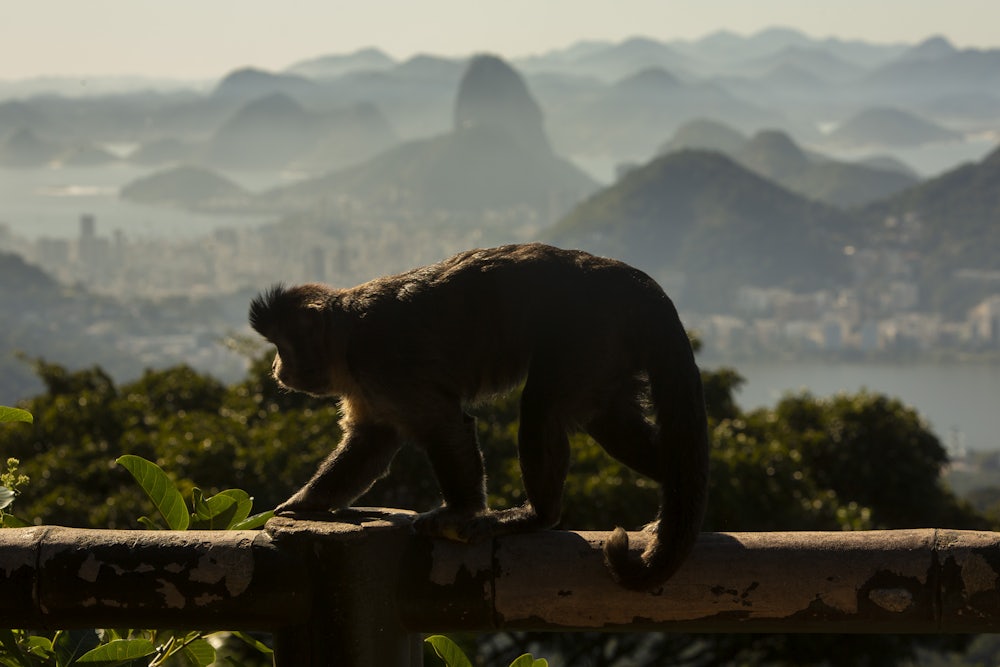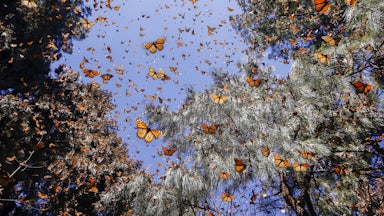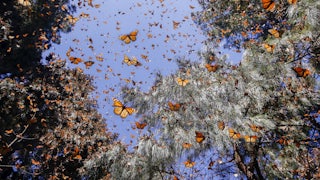In the coastal, rainy city of Kanazawa, Japan, landscape architect and researcher Juan Pastor-Ivars discovered something surprising: Gardens in the center of this city of 460,000 contain species of animals, plants, and insects that no longer live in the surrounding mountains and protected wildlife areas outside the city. Meanwhile, on the other side of the globe, scientists discovered that an astounding 2 percent of the world’s species can be found within the borders of Mexico City, a metropolis of nearly nine million people.
These recent findings emphasize that humans don’t always need to be destructive forces on the environment—in fact, they can be positive influences on biodiversity and life. And one particularly counterintuitive implication is that a rich, biodiverse ecosystem doesn’t have to be at odds with dense city-building.
In Kanazawa, preserving these enclosed, urban gardens located in the center of the city’s commercial and residential districts is a serious challenge in the face of depopulation and changing values. But it’s one essential initiative in a new global trend of cities seeing themselves as tools of ecological conservation and climate change mitigation.
As one of several initiatives to preserve these hubs of urban biodiversity, Ivars works with the United Nations University’s Sustainable Urban Nature project to increase the awareness of owners, showing them just how much their gardens contribute to offsetting carbon, preventing biodiversity loss, or alleviating the impacts of climate change. As is true in many gardens the world over, these plots weren’t necessarily cultivated with biodiversity or carbon in mind; this project involves shifting the social meaning of these private gardens. “Traditional Japanese gardens originated from spiritual beliefs and turned into aesthetic objects over time,” says Ivars. “But because of a loss of these cultural values, it’s been hard to maintain and preserve them. So our project finds a new value in these gardens: environmental value.”
Over the past few decades, many cities have embraced “going green.” But the slogan typically means reducing emissions: improving insulation and constructing LEED-certified buildings, investing in public transit, and using electricity generated from renewable resources. In recent years, some cities are starting to expand beyond that. At the City Biodiversity Network convention in 2010 and 2015, U.N. member states adopted plans of action for local and subnational governments to address biodiversity. Now, cities, scientists, and communities from Kanazawa to Rio de Janeiro and Helsinki are working to engage locals to create sustainable urban nature in the hearts of cities. Rather than locking up pristine wilderness untouched by human hands, the future of conservation will see nature preserved and encouraged to grow alongside urban life.
The planet’s current biodiversity crisis is every bit as dire as the related climate crisis. A 2022 World Wildlife Fund study found that wildlife populations have declined by an average of 69 percent in the past 50 years and have estimated that half of all species could be extinct by 2050, thanks to deforestation, invasive species, pollution, overfishing, and climate change, among other factors. This kind of cascading species collapse threatens agriculture, medicine, tourism, and even public health on a massive scale.
Investing in biodiversity could benefit urban centers directly, too. Countless studies have shown that engaging in nature improves the well-being and mood of urban residents—not to mention assisting with more practical concerns. Thomas Elmqvist, professor in natural resource management at Stockholm University, goes so far as to describe biodiversity as a way of investing in a city’s adaptability to climate change. “Cities depend on ecosystems for water purification, for food production—cities are not isolated islands,” Elmqvist told me. “Functioning ecosystems in urban areas improve human health, reduce the effects of heat waves and drastic precipitation, and so on.”
Nowhere can both the difficulties and rewards of preserving urban biodiversity be better seen than in the most biodiverse city in the world: Cape Town, South Africa. Cape Town’s jurisdiction includes the major coastal nature reserves and expansive parkland that overlaps with human settlements. From zebras to ostriches to penguins and whales, Cape Town contains 3,000 species of plants, 361 species of birds, and 83 mammal species, an incredible 50 percent of all mammal species in South Africa.
But according to Tony Rebelo, a scientist at the South African National Biodiversity Institute, or SANBI, Cape Town also has the most threatened species in the world. Three hundred eighteen types of plants, 22 types of birds, and 24 types of animals are all under threat of extinction. A lot of this remarkable biodiversity comes from Cape Town’s unique fynbos shrubland ecosystem, which requires fires to thrive. Decreasing incidence of fires, illegal dumping and bark stripping, sewage overflow, and increased city and residential fencing and walling have all contributed to biodiversity loss in the world’s ultimate urban biodiversity hot spot.
Some conservation and restoration initiatives—for example cutting down non-native trees to protect the city’s water supply in a time of urgent drought—are easier sells than others. Many of the current successful efforts, Rebelo says, focus on man-made urban areas like parks rather than the natural wildlife areas in the city’s coastal, mountainous, and agricultural regions—areas that are also vital to Cape Town’s recreation, tourism, and wine and culinary culture.
“[Due to the need for fires,] conflicting management needs mean that urban and conservation areas need to be separate, with clear distinct boundaries,” says Rebelo. “So long as the boundaries are adequately demarcated, and the authorities managing the areas are aware of the urban park versus indigenous reserve management requirements, there should be no issue with them coexisting in the urban environment.”
Rio de Janeiro is another city that encompasses thriving ecosystems—woods, mountains, mangrove forests, shoals, lagoons, and beaches—within the same urban borders that contain sprawling favelas and a bustling city center. Guilherme Cruz de Mendonca, professor of environmental law at the Federal Institute of Rio de Janeiro, says that Rio is a powerful example of how cultural diversity and biological diversity rely on each other to thrive.
“Rio is a very unequal society,” says Mendonca. “There’s the favelas, the very poor, and the very rich. But places like beaches, parks, and forests are places where biological and geological diversity are a platform for social groups to coexist in the city.” Unesco even designated the cultural landscape of Rio as a world heritage site, specifically the way the culture of the city revolves around the mountains, forests, and beaches that make up its natural landscape.
The most urgent struggles in Rio revolve around conflicts over access to biodiversity. This can be seen when slums try to expand into natural areas, or the rich advocate changing bus routes to hinder access to the beaches from certain neighborhoods. “We have policies, instruments to deal with biodiversity and biocultural diversity, at least on paper,” says Mendonca. “They’re not necessarily well implemented.”
These kinds of complicating factors when it comes to preserving urban biodiversity can be seen in much richer countries as well. Helsinki, for example, features a relatively high number of species and has implemented a robust biodiversity policy for the last 20 years. That includes regulation that establishes new protected areas in the city administrative region so as to increase the total amount of protected areas.
With a rapidly growing city, however, Helsinki faces the challenging decision of whether to build densely to lower the urban carbon footprint, or to incorporate more green space to promote biodiversity. “We have been developing new tools that bring in or maintain the existing nature at a certain level in newly built housing,” says Kati Vierikko, a senior researcher at the Finnish Environment Institute. “But it’s tricky because if the only concern is climate, then the denser the city, the lower the carbon footprint, which is in conflict with maintaining green in densely built areas.”
Kanazawa has the opposite problem: Population decline has led to an increase in abandoned plots without people to manage them. Ivars has worked on projects to evaluate abandoned land and work with owners to turn the land into cheap vegetable farms and flower gardens for use by neighbors and locals and promote biodiversity in the process.
With the bullet train coming to the city in 2015, Kanazawa also saw a huge increase in foreign tourism, which brings money, but has also threatened locals, urban infrastructures, and even ecosystems in cities like Venice, Barcelona, and Kyoto. Ivars says Kanazawa’s new approach is to build sustainable tourism around the city’s green infrastructure.
“This means owners opening up their gardens once or twice a month to visitors, running open garden and ecotourism activities to help maintain these gardens,” says Ivars. “I see big potential for Kanazawa using this traditional green infrastructure as the city’s tourist image.”
One throughline in all these examples, from Japan to South Africa, Brazil to Finland, is that citizen and community engagement are paramount to improving biodiversity in cities. “Unlike the climate discussion, biodiversity is mostly a local issue, so the solutions are also local,” explains Elmqvist. “That’s why it makes sense to have local communities and governments deeply involved in the implementation and finding of these local solutions. You need to constantly raise awareness among citizens.”
Furthermore, each city struggles with different competing and intersecting priorities. Not only will urban conservation differ from the wilderness conservation approaches of prior decades, but urban conservation strategies will necessarily vary from city to city. That could mean strict preservation measures in Cape Town that balance water management goals, enhancing access to nature in Rio, decentralized forest building in Helsinki, and doubling down on private gardens as biodiversity banks by managing them publicly and opening them up to tourism in Kanazawa.
The benefits of biodiversity—from improving human health and well-being to managing future climate uncertainty—should make it a top priority for urban governments and local organizers. Beyond just crafting a new vision of “going green” that includes biodiversity, cities and governments need to reimagine conservation writ large, bringing it into our cities, and finding a way to pursue it equitably.










